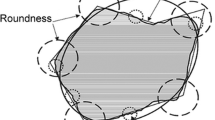Abstract
The stress–strain and stress path characteristics of sands are influenced by their grain size, shape, and packing. Morphological characteristics and size of particles play important role on the undrained shear strength of sands. Often, effects of these parameters are complex and cannot be easily distinguished. This study advances the knowledge of the role of particle size and shape on the undrained shear strength of sands. To eliminate the consequence of morphological characteristics, two sands with different particle sizes but similar angularity, and another sand with different roundness were selected for the study. These morphological characteristics for all three sands were determined from the analysis of scanning electron microscope images. F131 sand with higher median grain size and lower shape factors (rr and rs) had highest undrained peak shear strength and phase transformation value. Undrained strength (qpt) and effective principal stress (P′pt) in phase transformation point had direct relationship with grain median grain size (D50) and inversely effect of shape factor (rr and rs). F131 and F161 sands represented highest peak and ultimate steady-state strengths, respectively. Flow potential appeared to be directly proportional with (rr and rs) and inversely with D50. The peak index decreased with increasing shape factors (rr and rs).











Similar content being viewed by others
References
Kakou BG, Shimizu H, Nishimura S (2001) Residual strength of colluvium and stability analysis of farmland slope. Agric Eng Int CIGR J Sci Res Dev 3:1–12
Petley DJ (1966) the shear strength of soils at large strains. PhD thesis, University of London
Holtz WG, Gibbs HJ (1956) Triaxial shear tests on previous gravelly soils. J Soil Mech Found Div ASCE 820(SM1):1–22
Patwardhan AS, Rao JS, Gaidhane RB (1970) Interlocking effects and shearing resistance of boulders and large size particles in a matrix of fines on the basis of large scale direct shear tests. In: Proc 2nd Southeast Asian conf soil mech Singapore, pp 265–273
Vallejo LE, Zhou Y (1994) The mechanical properties of simulated soil-rock mixtures. In: Proc 13th int’l conf soil mech and found engrg, New Delhi, pp 365–368
Prakasha KS, Chandrasekaran VS (2005) Behavior of marine sand–clay mixtures under static and cyclic triaxial shear. J Geotech Geoenviron Eng 131(2):213–222
Cho GC, Dodds J, Santamarina JC (2006) Particle shape effects on packing density, stiffness, and strength: natural and crushed sands. J Geotech Geoenviron Eng 132:591–602
Simoni A, Houlsby GT (2006) The direct shear strength and dilatancy of sand–gravel mixtures. Geotech Geol Eng 24:523–549
Ghadr S, Assadi-Langroudi A (2018) Structure-based hydro-mechanical properties of sand-bentonite composites. Eng Geol 235:53–63
Tsomokos A, Georgiannou VN (2010) Effect of grain shape and angularity on the undrained response of fine sands. Can Geotech J 47:539–551
Oda M, Koishikawa I, Higuchi T (1978) Experimental study of anisotropic shear strength of sand by plane strain tests. Soils Found 18(1):25–38
Dyskin AV, Estrin Y, Kanel-Belov AJ, Pasternak E (2001) Toughening by fragmentation—how topology helps. Adv Eng Mater 3(1):885–888
Lim MS, Wijeyesekera DC, Zainorabidin A, Bakar I (2012) The effects of particle morphology (shape and sizes) characteristics on its engineering behaviour and sustainable engineering performance of sand. Int J Integr Eng 4:27–37
Wadell H (1932) Volume, shape, and roundness of rock particles. J Geol 40(5):443–451
Hight DW, Georgiannou VN, Martin PL, Mundegar AK (1998) Flow slides in micaceous sand. In: Yanagisawa E, Moroto N, Mitachi T (eds) Problematic soils, Sendai, pp 945–958
Cubrinovski M, Ishihara K (2002) Maximum and minimum void ratio characteristics of sands. Soils Found 42(6):65–78
Guimaraes M (2002) Crushed stone fines and ion removal from clay slurries—fundamental studies. Ph.D. thesis, Georgia Institute of Technology, Atlanta
Santamarina JC, Cho GC (2004) Soil behaviour: the role of particle shape. In: Proc. skempton conf. advances in geotechnical engineering, vol 1, London, pp 604–617
Shahu JT, Yudhbir (1998) Model tests on sands with different angularity and mineralogy. Soils Found 38(4):151–158
Yagiz S (2001) Brief note on the influence of shape and percentage of gravel on the shear strength of sand and gravel mixtures. Bull Eng Geol Environ 60(4):321–323
Nouguier-Lehon C, Cambou B, Vincens E (2003) Influence of particle shape and angularity on the behaviour of granular materials: a numerical analysis. Int J Numer Anal Methods Geomech 27(14):1207–1226
Kramer SL, Seed HB (1988) Initiation of soil liquefaction under static loading conditions. J Geotech Eng 114:412–430
Hight DW, Bennell JD, Chana B, Davis PD, Jardine RJ, Porovi E (1997) Wave velocity and stiffness measurements of the Crag and Lower London tertiaries at sizewell. Geotechnique 47:451–474
Jefferies MG, Been K (2006) Soil liquefaction: a critical state approach. Taylor and Francis, Abingdon
Ishihara K (1993) Liquefaction and flow failure during earthquakes. In: 33rd rankine lecture, geotechnique 43, no 3, pp 351–415
Lade PV, Ibsen LB (1997) A study of the phase transformation and the characteristic lines of sand behaviour. In: International symposium on deformation and progressive failure in geomechanics, Nagoya
Vaid YP, Sivathayalan S (2000) Fundamental factors affecting liquefaction susceptibility of sands. Can Geotech J 37:592–606
Yoshimine M, Robertson PK, Wride CE (1999) Undrained shear strength of clean sands to trigger flow liquefaction. Can Geotech J 36:891–906
Yoshimine M, Ishihara K (1998) Flow potential of sands during liquefaction. Soils Found 38(3):189–198
Yoshimine M, Ishihara K, Vargas W (1998) Flow deformation of sands subjected to principal stress rotation. Soils Found 38(3):179–188
Author information
Authors and Affiliations
Corresponding author
Additional information
Publisher's Note
Springer Nature remains neutral with regard to jurisdictional claims in published maps and institutional affiliations.
Rights and permissions
About this article
Cite this article
Ghadr, S., Assadi-Langroudi, A. Effect of Grain Size and Shape on Undrained Behaviour of Sands. Int. J. of Geosynth. and Ground Eng. 5, 18 (2019). https://doi.org/10.1007/s40891-019-0170-1
Received:
Accepted:
Published:
DOI: https://doi.org/10.1007/s40891-019-0170-1




